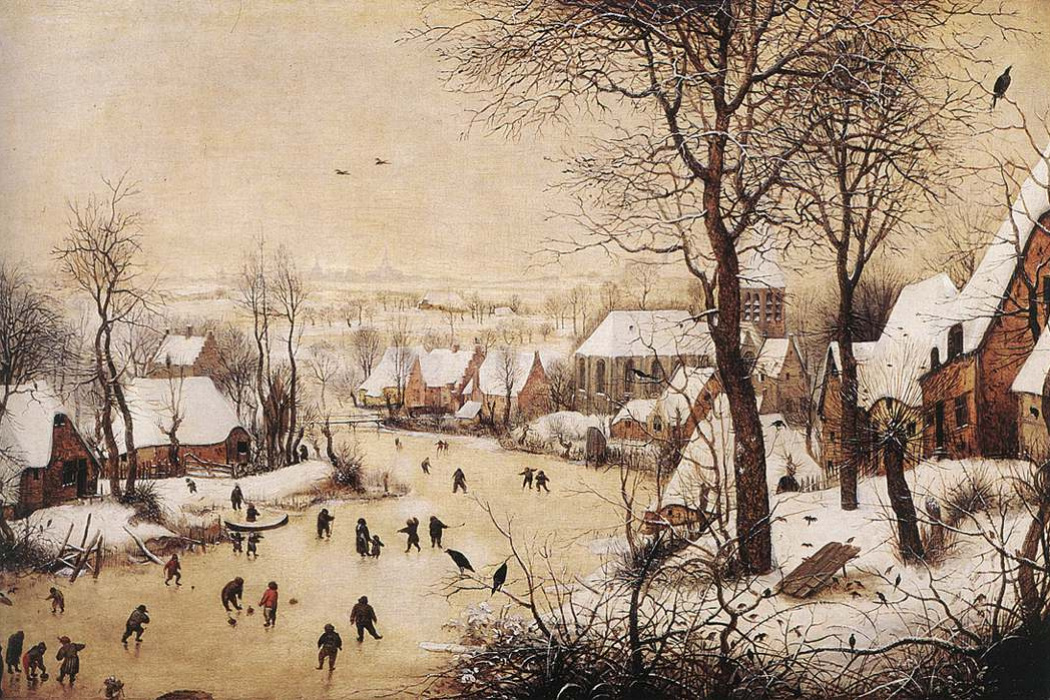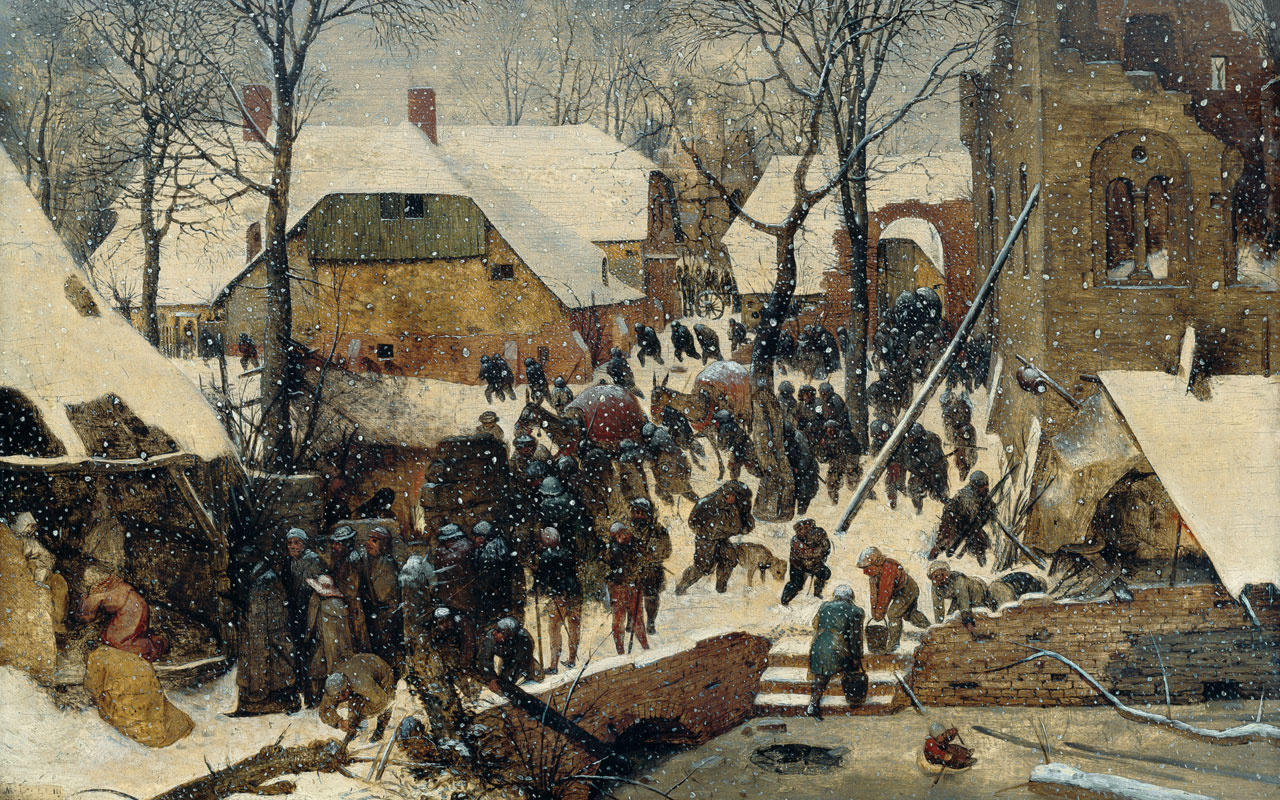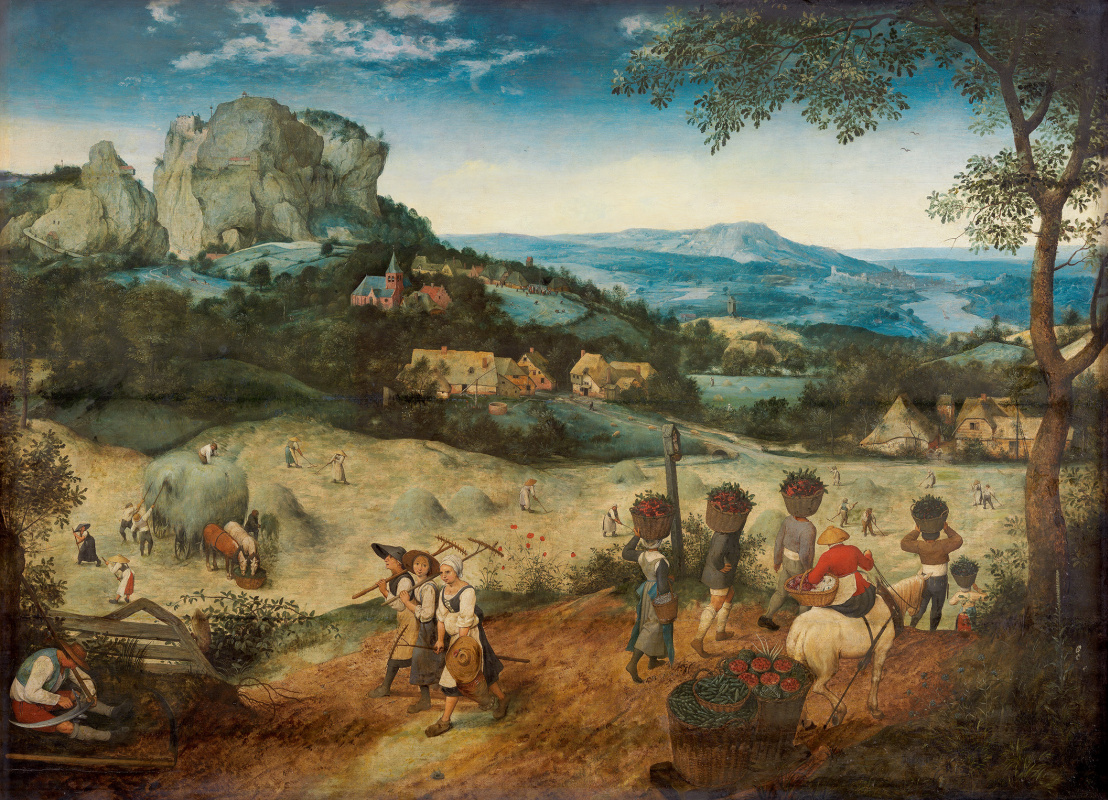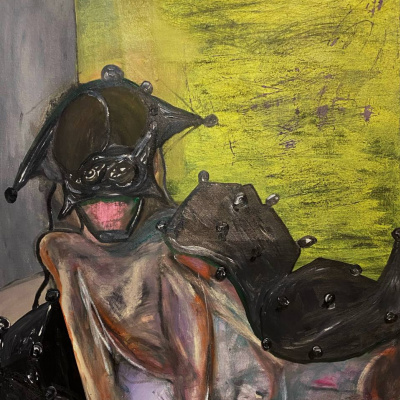Many see a festive atmosphere in the first significant winter landscapes in European art, those of Pieter Bruegel the Elder. Indeed, the bizarre snow scenes painted by the Flemish artist are often featured on Christmas cards. People in the pictures are skating on frozen rivers, playing an early version of hockey with sticks and stones, trying to catch birds. At first glance, they seem to admire the sheer beauty before them. But this pastoral sense of joy has mostly arisen a century later, when we have already learned to defend ourselves from the winter chill.

In the Hunters in the Snow (1565), one of the most famous images in Western culture, three men and their skinny dogs, wet, exhausted and hunched over from the cold, return home from a hunting expedition. They come to the top of the hill and catch a glimpse of a winter wonderland stretching out in front of them in the valley below. Bruegel introduces the viewer to the vast landscape
precisely from the hunters' point of view — the gaze slides over the picture on the left, following their footsteps in the snow.
But for both the artist and ordinary people in his paintings, this view carries a smack of bitter joy. At the time Bruegel painted his panels, Europe was undergoing a period of intense climate change, now known as the Little Ice Age.
But for both the artist and ordinary people in his paintings, this view carries a smack of bitter joy. At the time Bruegel painted his panels, Europe was undergoing a period of intense climate change, now known as the Little Ice Age.
Hunters in the snow
1565, 117×162 cm
This term was first used in 1939 to describe a period of four thousand years, but now scientists have narrowed it down to 1300—1850, when an intense cold snap occurred. Ironically, this is one of the most fruitful epochs in the history of art. The 1560s are considered by many to be the first decade of the extreme weather, and the winters of 1564 and 1565 are cited as the coldest in the century. Bruegel’s paintings such as Hunters in the Snow and other famous scenes such as Winter Landscape
with a Bird Trap and Skaters and Adoration of the Magi in a Winter Landscape
were created as a result of these events.
During this time, the rivers froze so much that local residents opened tax-free trading platforms on them. The trees formed such a strong and unique wood that Antonio Stradivari used it to create his unique instruments, which are still worth their weight in gold all over the world. But the annual food shortages caused unrest and disease throughout Europe. The number of suicides increased. People believed that the loss of crops or infant mortality was God’s punishment. They blamed witches for their misfortunes, and this led to the executions of thousands of women.
During this time, the rivers froze so much that local residents opened tax-free trading platforms on them. The trees formed such a strong and unique wood that Antonio Stradivari used it to create his unique instruments, which are still worth their weight in gold all over the world. But the annual food shortages caused unrest and disease throughout Europe. The number of suicides increased. People believed that the loss of crops or infant mortality was God’s punishment. They blamed witches for their misfortunes, and this led to the executions of thousands of women.
Winter landscape with ice-skating and a trap for birds
1565, 37×55.5 cm
In 1561, a red sky was observed over northern Europe, and churchmen interpreted this as an omen. As if confirming their theory, the Great Plague epidemic swept across Austria, and summer storms raged throughout Europe until the end of the century. In 1563, in the southern German town of Wiesensteig alone, 63 women were burnt at the stake. More than 30 years later, in the Demonology witch-hunting treatise of the English king James I, the use of witchcraft to worsen the weather was mentioned. Witchcraft was the obsession of the time reflected in works such as William Shakespeare’s Macbeth and The Legend of Faust, first published in 1587.
The theologian Johannes Molanus who lived in Leuven near Bruegel described the winter of 1564—1565 as "immensely harsh". At this time, terrible floods occurred in the Brabant region, where the artist was supposedly born. Molanus tells of the poor frostbitten people who lost their noses, hands and genitals due to the cold. Birds fell dead from the sky. Bruegel reflected this situation in his Massacre of the Babies painting (1565—1567), emphasizing the inhumanity of the biblical story with the brutality of weather conditions.
The theologian Johannes Molanus who lived in Leuven near Bruegel described the winter of 1564—1565 as "immensely harsh". At this time, terrible floods occurred in the Brabant region, where the artist was supposedly born. Molanus tells of the poor frostbitten people who lost their noses, hands and genitals due to the cold. Birds fell dead from the sky. Bruegel reflected this situation in his Massacre of the Babies painting (1565—1567), emphasizing the inhumanity of the biblical story with the brutality of weather conditions.
The massacre of the innocents
1567, 109.2×158.1 cm
Before these harsh winters, the artist travelled through Italy. "Having been in the Alps, he swallowed all the mountains and rocks, and when he returned home, he spat them out on his canvases and panels," Karel van Mander said floridly in his 1604 biography. While Van Mander’s notes on Bruegel are sometimes questioned, they still represent the artist’s most authentic portrait. It is an undoubtful fact that the mountains actually had a profound influence on him: in the upper right corner of the Hunters in the Snow, above a typical Flemish village, he depicted alpine peaks.
Bruegel lived and worked in this world.
Bruegel was the first to make winter landscapes the central theme of serious painting. Previously, they featured in tapestries and engravings, occupied corners of larger works or margins of illuminated manuscripts. The harsh winter seems to have entered the very bones of the artist — the cold quickly became an integral part of his vision. In The Adoration of the Magi in a Winter Landscape
(1563), his first attempt to paint snow, he almost completely hid Mary, Joseph and baby Jesus behind a snowstorm. Dutch artists of the 17th century, as well as wealthy patrons, embraced the entirely new genre largely due to the popularity of Bruegel’s snow scenes, copies of which were widely circulated thanks to his son Peter Bruegel the Younger and other artists.
The adoration of the Magi in winter landscape
1567, 35×55 cm
The Hunters in the Snow was ordered by a merchant banker Nicolaes Jonghelinck. The painting was one of six panels in the Months series that adorned the dining room of his country house near Antwerp. Each scene illustrated two months of the year. Unfortunately, only four other works from this cycle have come down to us. The Hunters in the Snow symbolizes the harsh winter months of December and January. Others depict farmers engaged in seasonal work such as planting and harvesting. But the Hunters is a pause in the natural development of the plot. It reflects the natural interruption that took place in the life of Flemings during the winter months.
The human figures are twice captioned here, captioned by frost and by the artist, as well as the pace of life that has slowed down in the pastoral off-season. Today, during bad weather, public schools and institutions are closed, public transport stops, and people eager not to leave their homes. In Bruegel’s time, stubborn hunters only went into the forest to return with one little fox. In the lower right corner, a hunched figure drags a bundle of brushwood across the bridge. This man is a kind of mockery of a detail from the Haymaking, painted earlier in the same year, depicting villagers carrying baskets of fruit on their heads in the warm summer months of June and July.
The human figures are twice captioned here, captioned by frost and by the artist, as well as the pace of life that has slowed down in the pastoral off-season. Today, during bad weather, public schools and institutions are closed, public transport stops, and people eager not to leave their homes. In Bruegel’s time, stubborn hunters only went into the forest to return with one little fox. In the lower right corner, a hunched figure drags a bundle of brushwood across the bridge. This man is a kind of mockery of a detail from the Haymaking, painted earlier in the same year, depicting villagers carrying baskets of fruit on their heads in the warm summer months of June and July.
Haymaking. The cycle "Seasons", early summer
1565, 114×158 cm
In the Hunters, Bruegel’s characters draw joy from the punishing nature, just as the artist finds beauty in the scene that his contemporaries would hardly find inspiring. He did not depict a clear winter day, his scene is dull, almost gloomy. The colour of the sky is between steel blue and malachite, it is reflected in the ice on the river.
The painting by Bruegel, as those later by William Turner, is both impressionistic and true. The sharpness of the compositions of the both authors is provided by the artist’s ability to capture different shades and textures of snow. Take a closer look at the hunters' traces — we can physically feel the weight of the person closest to us, who falls into the snow. See how well the artist rendered other fragments where people were fighting the cold. For example, the smoke and flames from the fire at the inn’s tavern to the left appear almost blurry and create a sense of pure movement, just as in The Census at Bethlehem, created a year later. Looking at this icy, but undoubtedly beautiful work, one gets the feeling that Bruegel hesitated between an impulse to get rid of the horror of winter and show its harsh beauty at the same time. Perhaps he was never able to make a final decision, but this ambiguous result is strikingly powerful.
The painting by Bruegel, as those later by William Turner, is both impressionistic and true. The sharpness of the compositions of the both authors is provided by the artist’s ability to capture different shades and textures of snow. Take a closer look at the hunters' traces — we can physically feel the weight of the person closest to us, who falls into the snow. See how well the artist rendered other fragments where people were fighting the cold. For example, the smoke and flames from the fire at the inn’s tavern to the left appear almost blurry and create a sense of pure movement, just as in The Census at Bethlehem, created a year later. Looking at this icy, but undoubtedly beautiful work, one gets the feeling that Bruegel hesitated between an impulse to get rid of the horror of winter and show its harsh beauty at the same time. Perhaps he was never able to make a final decision, but this ambiguous result is strikingly powerful.
The census at Bethlehem
1566, 115.5×163.5 cm
The Hunters in the Snow is infinitely far from Christmas cards. But some silvery accents confirm what the chroniclers observed during this treacherous peak of the Little Ice Age. Thus, local residents took advantage of the opportunity to arrange duty-free trade and attractions on frozen rivers and ponds. They also competed in games that are popular with us today. These adversities have brought people together, and the Hunters in the Snow exemplifies their resourcefulness, endurance, will to survive and the ability to find additional joys in cold climates. The Bruegel’s paintings celebrate the relationship between man and nature, no matter how harsh it may be.
Reflections on Bruegel’s winter paintings are especially relevant now, when we are faced with extreme climate changes due to human impact on nature. Global warming will entail constant repetition of small ice ages. Bruegel reminds us that cold has its own beauty.
Reflections on Bruegel’s winter paintings are especially relevant now, when we are faced with extreme climate changes due to human impact on nature. Global warming will entail constant repetition of small ice ages. Bruegel reminds us that cold has its own beauty.
Based on materials from Artsy.net





























